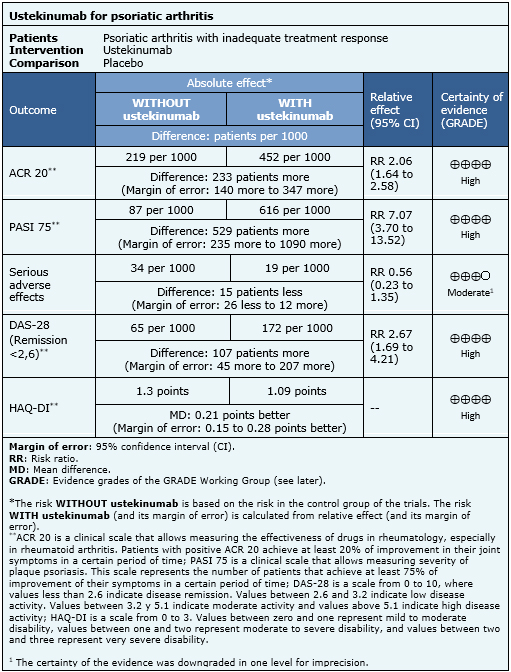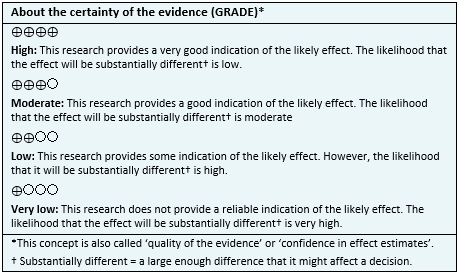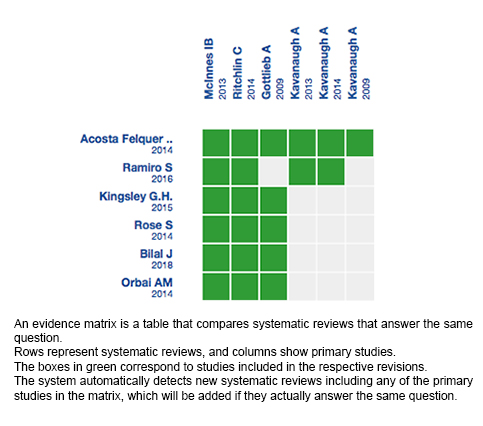Resúmenes Epistemonikos
← vista completaPublicado el 8 de marzo de 2018 | http://doi.org/10.5867/medwave.2018.02.7173
¿Es efectivo el ustekinumab para la artritis psoriásica que no responde a tratamiento inicial?
Is ustekinumab effective for psoriatic arthritis with insufficient response to initial treatment?
Abstract
INTRODUCTION Psoriatic arthritis is an inflammatory arthritis without a clear etiology. Biological therapy is key for its treatment, especially in more complex patients. There are several alternatives for biological treatment, but due to its high cost, it is important to evaluate their real effectiveness.
METHODS To answer this question we used Epistemonikos, the largest database of systematic reviews in health, which is maintained by screening multiple information sources, including MEDLINE, EMBASE, Cochrane, among others. We extracted data from the systematic reviews, reanalyzed data of primary studies, conducted a meta-analysis and generated a summary of findings table using the GRADE approach.
RESULTS AND CONCLUSIONS We identified 12 systematic reviews including three randomized trials overall. We concluded ustekinumab leads to clinical improvement in psoriatic arthritis, and probably is not associated to severe adverse effects.
Problem
Psoriatic arthritis is an inflammatory arthritis without a clear etiology. It is associated with psoriasis, and most are seronegative for rheumatoid factor. Currently, there are several treatment alternatives for this condition, many of them extrapolated from drugs proven in rheumatoid arthritis. The efficacy of new medications in psoriatic arthritis has been studied in greater depth recently, especially for patients resistant to initial treatment, either with non-steroidal anti-inflammatories, disease modifying drugs (e.g. methotrexate) or biological medication (e.g. TNF inhibitors). Among these new alternatives is ustekinumab, an IL-12 and IL-23 inhibitor.
Methods
To answer the question, we used Epistemonikos, the largest database of systematic reviews in health, which is maintained by screening multiple information sources, including MEDLINE, EMBASE, Cochrane, among others, to identify systematic reviews and their included primary studies. We extracted data from the identified reviews and reanalyzed data from primary studies included in those reviews. With this information, we generated a structured summary denominated FRISBEE (Friendly Summary of Body of Evidence using Epistemonikos) using a pre-established format, which includes key messages, a summary of the body of evidence (presented as an evidence matrix in Epistemonikos), meta-analysis of the total of studies when it is possible, a summary of findings table following the GRADE approach and a table of other considerations for decision-making.
|
Key messages
|
About the body of evidence for this question
|
What is the evidence. |
We found twelve systematic reviews [1],[2],[3],[4],[5],[6],[7],[8],[9],[10],[11],[12], that include three primary studies, reported in six references [13],[14],[15],[16],[17],[18]. All of them are randomized controlled trials. This table and the summary in general are based on the latter. |
|
What types of patients were included* |
All of these trials included adult patients with clinical psoriatic arthritis diagnosis and active disease (three or more tender joints, plus C-reactive protein of 3 mg/L [13],[14] or 15 mg/L [15]) and inadequate response or poor tolerance to the use of non-steroidal anti-inflammatories or disease modifying drugs in addition to plaque psoriasis with active lesion or previous history of disease. One trial [13] excluded patients with previous anti-TNF use. On the other hand, the other two trials [14],[15] did include patients with inadequate response or poor tolerance to the use of biological therapies. |
|
What types of interventions were included* |
Two trials [13],[14] included subcutaneous ustekinumab 45 mg or 90 mg at baseline, then at week four, then every twelve weeks. One trial [15] did not report the dose or administration scheme. All trials compared against placebo. |
|
What types of outcomes |
The outcomes were pooled by the different systematic reviews as follows:
|
* The information about primary studies is extracted from the systematic reviews identified, unless otherwise specified.
Summary of Findings
The information on the effects of ustekinumab is based on three randomized trials that included 1073 patients overall [13],[14],[15]. Two trials reported ACR 20 , HAQ-DI, PASI-75 and DAS-28 [13],[14]. Three trials reported serious adverse events [13],[14],[15].
The summary of findings is the following:
- Ustekinumab improves ACR 20 in psoriatic arthritis. The certainty of the evidence is high.
- Ustekinumab improves PASI 75 in psoriatic arthritis. The certainty of the evidence is high.
- Ustekinumab probably leads to little or no difference in serious adverse events in psoriatic arthritis. The certainty of the evidence is moderate.
- Ustekinumab improves DAS-28 in psoriatic arthritis. The certainty of the evidence is high.
- Ustekinumab leads to an improvement of doubtful clinical relevance in HAQ-DI in psoriatic arthritis. The certainty of the evidence is high.

| Following the link to access the interactive version of this table (Interactive Summary of Findings – iSoF) |

Other considerations for decision-making
|
To whom this evidence does and does not apply |
|
| About the outcomes included in this summary |
|
| Balance between benefits and risks, and certainty of the evidence |
|
| Resource considerations |
|
| What would patients and their doctors think about this intervention |
|
|
Differences between this summary and other sources |
|
| Could this evidence change in the future? |
|
How we conducted this summary
Using automated and collaborative means, we compiled all the relevant evidence for the question of interest and we present it as a matrix of evidence.

Follow the link to access the interactive version: Ustekinumab for psoriatic arthritis
Notes
The upper portion of the matrix of evidence will display a warning of “new evidence” if new systematic reviews are published after the publication of this summary. Even though the project considers the periodical update of these summaries, users are invited to comment in Medwave or to contact the authors through email if they find new evidence and the summary should be updated earlier.
After creating an account in Epistemonikos, users will be able to save the matrixes and to receive automated notifications any time new evidence potentially relevant for the question appears.
This article is part of the Epistemonikos Evidence Synthesis project. It is elaborated with a pre-established methodology, following rigorous methodological standards and internal peer review process. Each of these articles corresponds to a summary, denominated FRISBEE (Friendly Summary of Body of Evidence using Epistemonikos), whose main objective is to synthesize the body of evidence for a specific question, with a friendly format to clinical professionals. Its main resources are based on the evidence matrix of Epistemonikos and analysis of results using GRADE methodology. Further details of the methods for developing this FRISBEE are described here (http://dx.doi.org/10.5867/medwave.2014.06.5997)
Epistemonikos foundation is a non-for-profit organization aiming to bring information closer to health decision-makers with technology. Its main development is Epistemonikos database (www.epistemonikos.org).
Potential conflicts of interest
The authors do not have relevant interests to declare.

